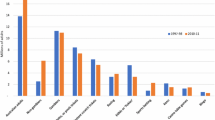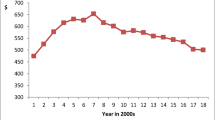Abstract
Regression modeling is used to predict gambling patterns in Australia on the basis of the unit record files underlying the Australian Bureau of Statistics’ Household Expenditure Survey of 6,892 households. The four largest categories of gambling expenditure are examined, namely: lottery tickets, lotto-type games and instant lottery (scratch cards), TAB (pari-mutuel wagering) and related on course betting, and poker (slot) machines and ticket machines. Determining factors analyzed include the source and level of household income, family composition and structure, welfare status, gender, age, ethnicity and geographic location. Apart from the determinants of expenditure varying widely across the different types of gambling activity, the results generally indicate that the source of household income is more important than the level of income and that household composition and regional location are likewise significant in determining gambling expenditure.
Similar content being viewed by others
References
Australian Bureau of Statistics. (2002). 1998–99 Household Expenditure Survey Australia, Confidentialised Unit Record File (CURF) Technical Paper (2nd ed.). ABS cat. No. 6544.0.30.001.
Borg, M. O., & Mason, P. M. (1988). The budgetary incidence of a lottery to support education. National Tax Journal, 41, 75–85.
Borg, M. O., Mason, P. M., & Shapiro, S. L. (1991). The incidence of taxes on casino gambling: Exploiting the tired and poor. American Journal of Economics and Sociology, 50, 323–332.
Borg, M. O., Mason, P. M., & Shapiro, S. L. (1993). The cross effects of lottery taxes on alternative state tax revenue. Public Finance Quarterly, 21, 123–140.
Cooper, S., & Cohn, E. (1994). Equity and efficiency of state lotteries: Review essay. Economics of Education Review, 13, 355–362.
Davis, J. R., Filer, J. E., & Moak, D. L. (1992). The lottery as an alternative source of state revenue. Atlantic Economic Journal, 20, 1–10.
Delfabbro, P. H., & Winefeld, A. H. (1999a). Poker machine gambling: An analysis of within-session characteristics. British Journal of Psychology, 90, 425–439.
Delfabbro, P. H., & Winefeld, A. H. (1999b). The danger of over-explanation in psychological research: A reply to Griffiths. British Journal of Psychology, 90, 447–450.
Farrell, L., & Walker, I. (1999). The welfare effects of lotto: Evidence from the UK. Journal of Public Economics, 72, 99–120.
Gambling Policy Directorate. (2001). Short analysis of Queensland and Australian Gambling Statistics. Queensland Government Treasury.
Garrett, T. A., & Marsh, T. L. (2002). The revenue impacts of cross-border lottery shopping in the presence of spatial autocorrelation. Regional Science and Urban Economics, 32, 501–519.
Hansen, A. (1995). The tax incidence of the Colorado state lottery instant game. Public Finance Quarterly, 23, 385–398.
Jackson, R. (1994). Demand for lottery products in Massachusetts. The Journal of Consumer Affairs, 28, 313–325.
Jacques, C., Ladouceur, R., & Ferland, F. (2000). Impact of availability on gambling: A longitudinal study. Canadian Journal of Psychiatry, 45, 810–816.
Kitchen, H., & Powells, S. (1991). Lottery expenditures in Canada: A regional analysis of determinants and incidence. Applied Economics, 23, 1845–1852.
Ladouceur, R. (1996). The prevalence of pathological gambling in Canada. Journal of Gambling Studies, 12, 129–142.
Layton, A. P., & Worthington, A. C. (1999). The impact of socioeconomic factors on gambling expenditure. International Journal of Social Economics, 26, 430–440.
Madhusudhan, R. G. (1996). Betting on casino revenues: Lessons from state experiences. National Tax Journal, 49, 401–412.
Productivity Commission. (1999). Public inquiry into the Australian gambling industry: Final Report. Canberra: Productivity Commission.
Pugh, P., & Webley, P. (2000). Adolescent participation in the U.K. national lottery games. Journal of Adolescence, 23, 1–11.
Rodgers, W. M., & Stuart, C. (1995). The efficiency of a lottery as a source of public revenue. Public Finance Quarterly, 23, 242–254.
Scoggins, J. F. (1995). The lotto and expected net revenue. National Tax Journal, 48, 61–70.
Scott, F., & Garen, J. (1994). Probability of purchase, amount of purchase, and the demographic incidence of the lottery tax. Journal of Public Economics, 54, 121–143.
Stanley, R. E., & French, P. E. (2003). Can students truly benefit from state lotteries: A look at lottery expenditures towards education in the American states. Social Science Journal, 40, 327–333.
Szakmary, A., & Szakmary, C. M. (1995). State lotteries as a source of revenue: A re-examination. Southern Economic Journal, 61, 1167–1181.
Thiel, S. E. (1991). Policy, participation and revenue in Washington state lotto. National Tax Journal, 44, 225–235.
Volberg, R. (1996). Prevalence of problem gambling in the United States. Journal of Gambling Studies, 12, 111–128.
Worthington, A. C. (2001). Implicit finance in gambling expenditures: Australian evidence on socioeconomic and demographic tax incidence. Public Finance Review, 29, 326–342.
Acknowledgements
The authors would like to thank three anonymous referees and the editor, Shoshana Grossbard, for helpful comments on an earlier version of this paper. The financial assistance of the Queensland Treasury’s Responsible Gambling Research Grant Program is also gratefully acknowledged.
Author information
Authors and Affiliations
Corresponding author
Rights and permissions
About this article
Cite this article
Worthington, A., Brown, K., Crawford, M. et al. Gambling participation in Australia: findings from the national Household Expenditure Survey. Rev Econ Household 5, 209–221 (2007). https://doi.org/10.1007/s11150-007-9006-1
Received:
Accepted:
Published:
Issue Date:
DOI: https://doi.org/10.1007/s11150-007-9006-1




